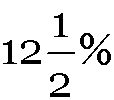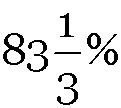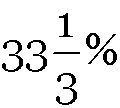Comparing Quantities Worksheet-2
-
Which of the following is the best investment?
(a) Rs. 2000 at 4.25% simple interest for 9 months
(b) Rs. 1200 at 8.5% simple interest for 6 months
(c) Rs. 1800 at 3.75% simple interest for 6 years
(d) Rs. 800 at 5% simple interest for one years
-
What principal must Mr. Harish put in the bank today to earn Rs. 285 simple interest in 2 years if the simple interest rate is 4.75%?
(a) Rs. 3,500 (b) Rs. 3,000 (c) Rs. 5,350 (d) Rs. 1,800
-
You deposit Rs. 5,000 in an account that earns 6.25% simple interest. How many years will it take your account balance to reach Rs. 7,500?
(a) 8 years (b) 12 years (c) 9 years (d) 5 years
-
Manav deposited Rs. 4,000 in an account. What simple interest rate must he get to have Rs. 8,080 in his account in 12 years?
(a) 7.5% (b) 8.25% (c) 8.5% (d) 12%
-
Find the missing value.
P = 600, I = 456, r = ?, t = 8 years
(a) 7.75% (b) 9.25% (c) 95% (d) 9.5%
-
Darpan deposited Rs. 3,000 in an account. How many years will it take his money to double at a simple interest rate of 10%?
(a) 5 years (b) 15 years (c) 10 years (d) 20 years
-
Brijesh invested Rs. 800 at 5% simple interest rate. How many years will it take his money to reach Rs. 1000?
(a) 4 years (b) 5 years (c) 2 years (d) 20 years
-
Mary borrowed Rs. 500 at 5% simple interest. The total interest payable over the period of the loan is Rs. 50. How many years will it take her to repay the loan?
(a) 3 years (b) 5 years (c) 8 years (d) 2 years
-
I = 56.55, r = 6.5%, t = 3 years P = ?
(a) Rs. 290 (b) Rs. 255 (c) Rs. 345 (d) Rs. 198
-
Rs. 25 as percentage of Rs.75 is
(a) 3% (b) 30% (c) 33.3% (d) 37%
-
In a city, 30% are females, 40% are males and remaining are children. Then the percentage of children is
(a) 35% (b) 30% (c) 32% (d) 31%
-
The cost price of 25 articles is equal to the selling price of 20 articles, gain% =
(a) 20% (b) 25% (c) 30% (d) 40%
-
If p is 6 times that of q, what percent is q less than p?
(a)  (b)
(b)  (c)
(c)  (d)
(d) 
-
40% of ? + 180 = 564, then the missing value is
(a) 960 (b) 860 (c) 950 (d) 850
-
In 2003, Indian cricket team played 60 games and won 30% of the games played. After a few phenomenal victories, this team raised its average to 50%. How many games did the team win in a row to attain this average?
(a) 36 (b) 24 (c) 48 (d) 12
-
A person sells 36 oranges per rupee and incurs a loss of 4%. How many oranges per rupees to be sold to have a gain of 8%?
(a) 32 (b) 30 (c) 28 (d) 34
-
In a map, 0.8 cm represents 8.8 km. How much distance will be represented by 80.5 cm on the map?
(a) 805 km (b) 885.5 km
(c) 644 km (d) 990 km
-
11 oranges are bought for Rs. 10 and 10 oranges are sold for Rs. 11. The gain (or) loss percent is
(a) 21% loss (b) 11% gain (c) 21% gain (d) 11% loss
-
In an election between two candidates, the candidate who gets 30% of the votes polled is defeated by 15,000 votes. What is the number of votes polled by the winning candidate?
(a) 37, 500 (b) 30, 000 (c) 26, 250 (d) 11, 250
-
A boy has enough money to buy 20 books. If each book costs 25 paise less, he could buy two more books and still have 70 paise left. The money boy has is
(a) Rs. 16 (b) Rs. 24 (c) Rs. 48 (d) Rs. 36
Answer Key:
(1)-(b); (2)-(b); (3)-(a); (4)-(c); (5)-(d); (6)-(c); (7)-(b); (8)-(d); (9)-(a); (10)-(c); (11)-(b); (12)-(b); (13)-(b); (14)-(a); (15)-(b); (16)-(a); (17)-(b); (18)-(c); (19)-(c); (20)-(c)
 (b)
(b)  (c)
(c)  (d)
(d) 